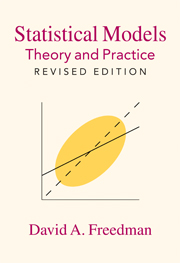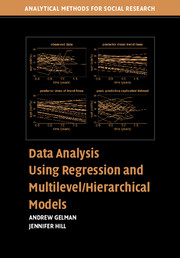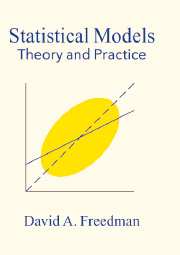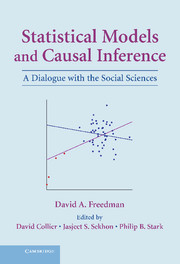Statistical Models
This lively and engaging textbook explains the things you have to know in order to read empirical papers in the social and health sciences, as well as the techniques you need to build statistical models of your own. The author, David A. Freedman, explains the basic ideas of association and regression, and takes you through the current models that link these ideas to causality. The focus is on applications of linear models, including generalized least squares and two-stage least squares, with probits and logits for binary variables. The bootstrap is developed as a technique for estimating bias and computing standard errors. Careful attention is paid to the principles of statistical inference. There is background material on study design, bivariate regression, and matrix algebra. To develop technique, there are computer labs with sample computer programs. The book is rich in exercises, most with answers. Target audiences include advanced undergraduates and beginning graduate students in statistics, as well as students and professionals in the social and health sciences. The discussion in the book is organized around published studies, as are many of the exercises. Relevant journal articles are reprinted at the back of the book. Freedman makes a thorough appraisal of the statistical methods in these papers and in a variety of other examples. He illustrates the principles of modeling, and the pitfalls. The discussion shows you how to think about the critical issues – including the connection (or lack of it) between the statistical models and the real phenomena. Features of the book: • authoritative guidance from a well-known author with wide experience in teaching, research, and consulting • careful analysis of statistical issues in substantive applications • no-nonsense, direct style • versatile structure, enabling the text to be used as a text in a course, or read on its own • text that has been thoroughly class-tested at Berkeley • background material on regression and matrix algebra • plenty of exercises, most with solutions • extra material for instructors, including data sets and code for lab projects (available from Cambridge University Press) • many new exercises and examples • reorganized, restructured, and revised chapters to aid teaching and understanding
- Authoritative guide by a well-known author with wide experience in teaching, research, and consulting
- Careful analysis of statistical issues in substantive applications
- New edition includes many new exercises and examples, and the author has reorganised, restructured and revised chapters to aid teaching and understanding
Reviews & endorsements
"At last, a second course in statistics that is serious, correct, and interesting. The book teaches regression, causal modeling, maximum likelihood, and the bootstrap. Everyone who analyzes real data should read this book, and we are extremely fortunate to now have the revised edition."
Persi Diaconis, Professor of Mathematics and Statistics, Stanford
University
"A pleasure to read, this newly revised edition of Statistical Models shows the field's most elegant writer at the height of his powers. While most textbooks hurry past core assumptions in order to explicate technique, this book places the spotlight on the core assumptions, challenging readers to think critically about how they are invoked in practice."
Donald Green, Professor of Political Science, Yale University
“For three decades, David Freedman has been the conscience of statistics as applied to important scientific, policy, and legal issues. This book is his legacy, and it is our great good fortune to have the new edition. It should be required reading for any user of multivariate models -- statistician or otherwise -- whose ultimate concern is not with statistical technique but rather with the substantive conclusions, if any, licensed by the data and the analysis.”
James M. Robins, Professor of Epidemiology and Biostatistics,
Harvard School of Public Health
"Statistical models: theory and practice is lucid, helpful, insightful and a joy to read. It focuses on the most common tools of applied statistics with a clear and simple presentation. This revised edition organizes the chapters differently, making reading much easier. Moreover, it includes many new examples and exercises. In summary, it is a nice and extremely useful addition to the statistical literature."
Heleno Balfarine, Mathematical Reviews
Product details
April 2009Hardback
9780521112437
458 pages
234 × 155 × 28 mm
0.73kg
21 b/w illus. 11 tables 404 exercises
Available
Table of Contents
- 1. Observational studies and experiments
- 2. The regression line
- 3. Matrix algebra
- 4. Multiple regression
- 5. Multiple regression: special topics
- 6. Path models
- 7. Maximum likelihood
- 8. The bootstrap
- 9. Simultaneous equations
- 10. Issues in statistical modeling.





